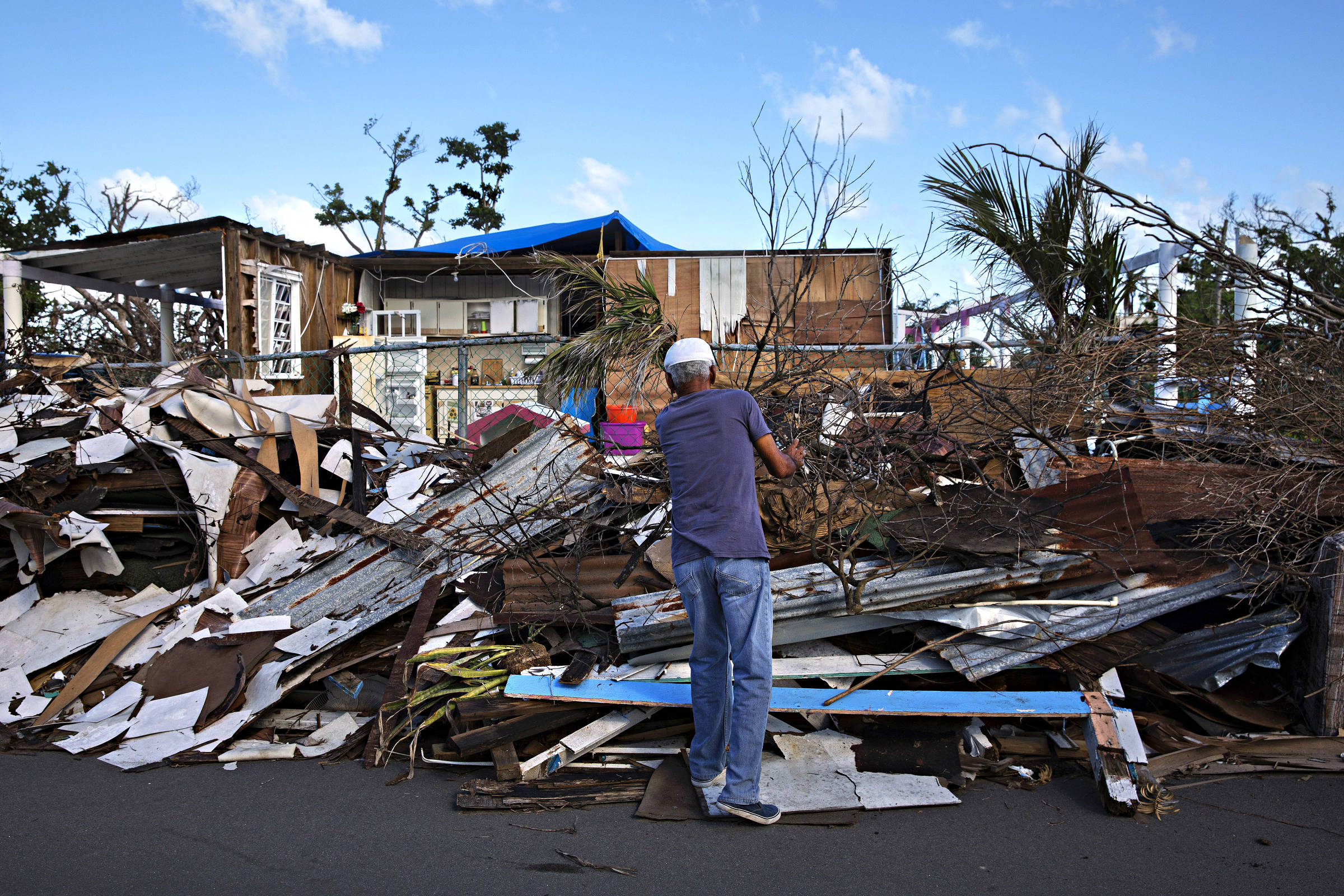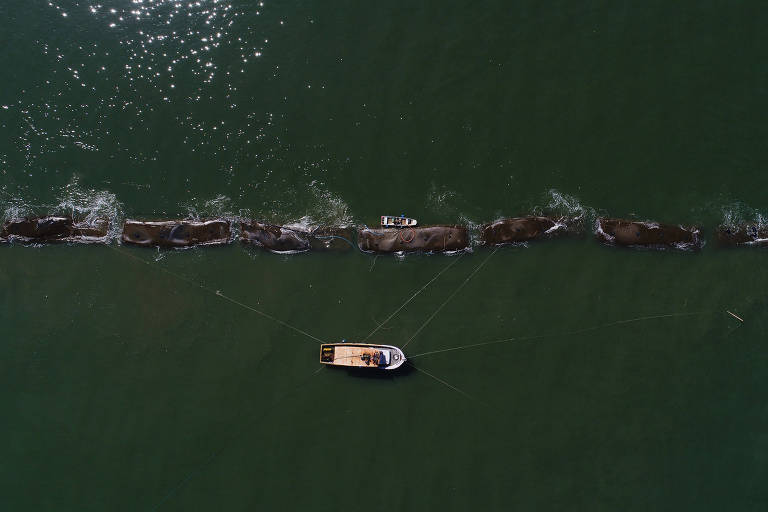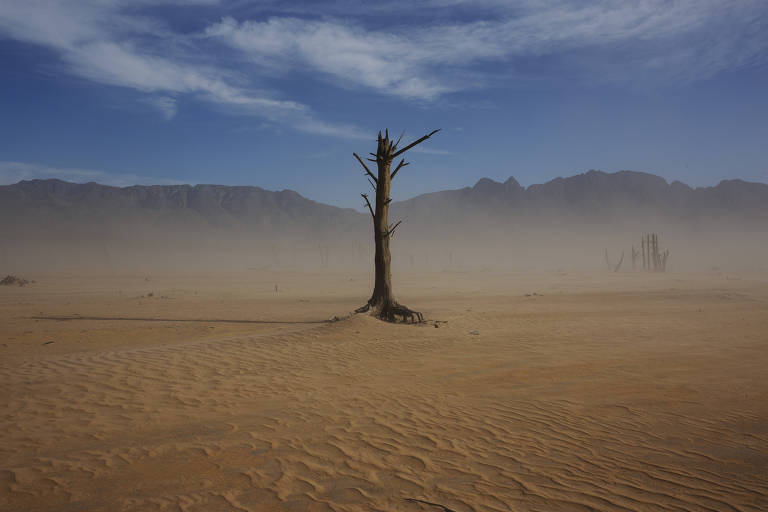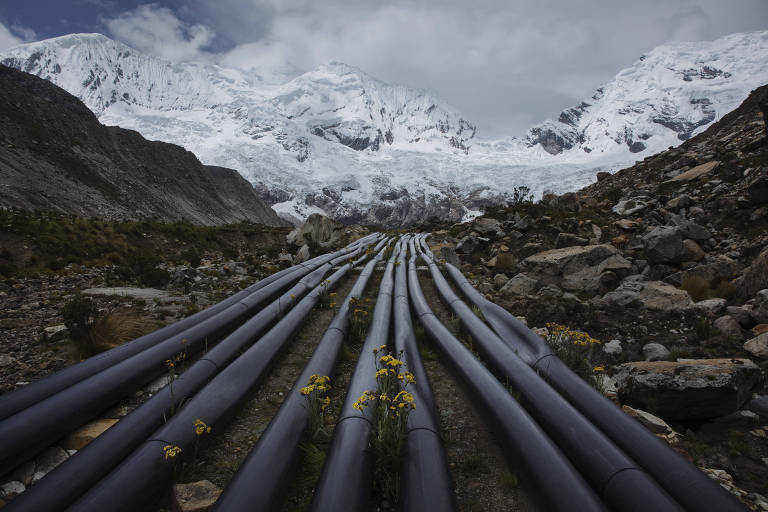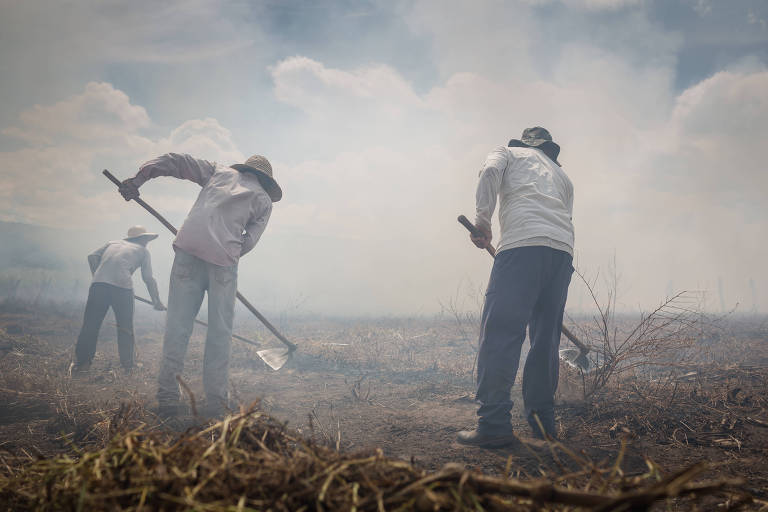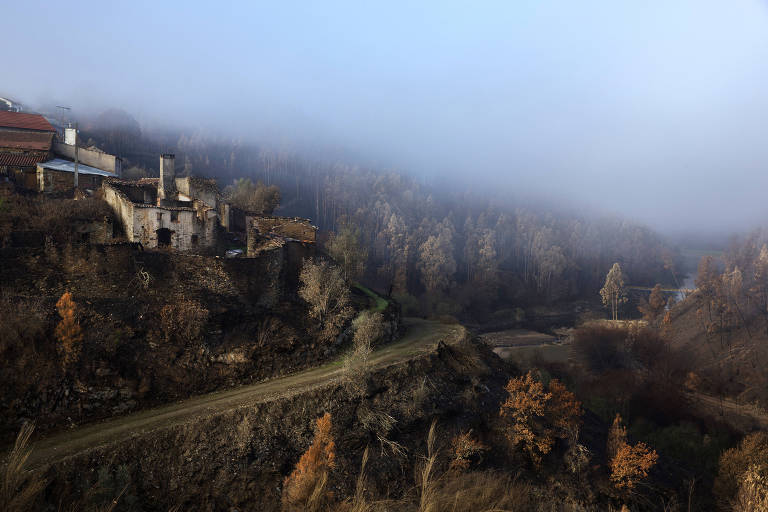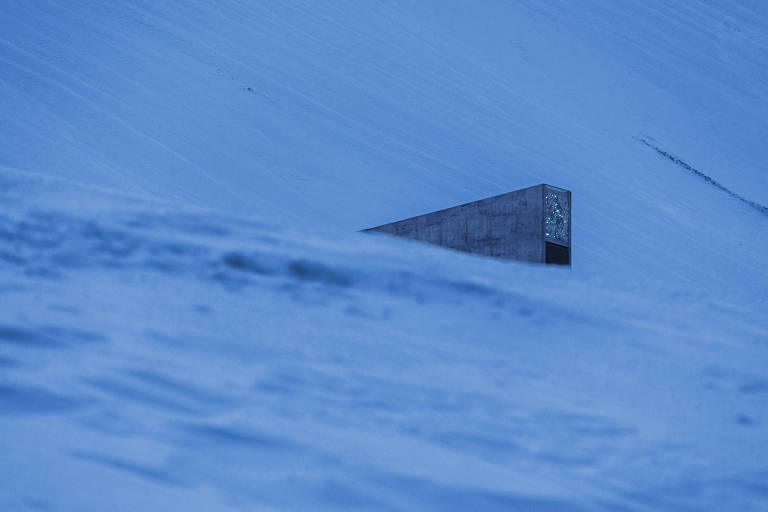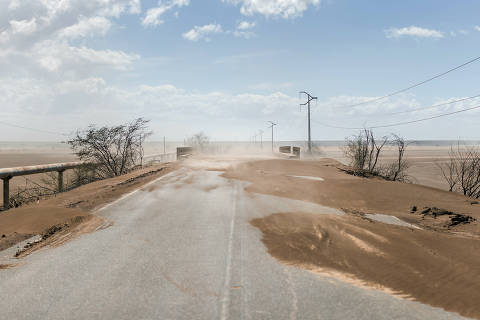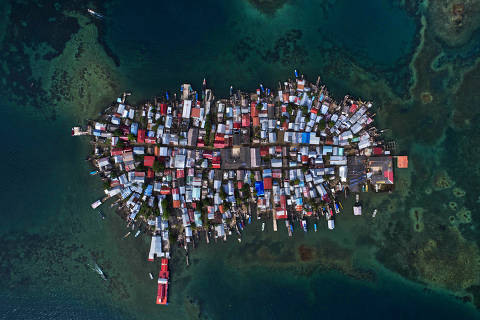Nearly 500000 are expected to leave Puerto Rico in the wake of Hurricane Marias devastation
15.mai.2018 - 02h00
{{video=3}}
{{lang=1|por,//staging.arte.folha.com.br/ciencia/2018/crise-do-clima/porto-rico/|esp,//arte.folha.uol.com.br/ciencia/2018/crisis-del-clima/puerto-rico/}}
Broken rotor blades littered the ground below Gestamp's massive wind turbines in Naguabo, Puerto Rico, leaving no doubt as to the strength of the wind. The wreckage was not as much about the power of alternative energy, though, as it was a testament to the climactic changes and conditions that unleashed the destructive fury of Hurricane Maria on September 20, 2017.
About 15 km (9 miles) from the destroyed wind farm in Naguabo, another source of clean energy was impacted by the accumulation of greenhouse gases in the atmosphere. In Humacao, shattered solar panels interrupted otherwise perfectly pristine rows of rectangular photovoltaic panes maintained by Reden Solar.
When Hurricane Maria made landfall, the Category 4 tempest struck the island with 250 km per hour (155mph) sustained winds. Over the open ocean, Maria reached category 5 strength, making it one of the most powerful hurricanes of 2017. The storm caused $90 billion in losses in Puerto Rico and left the United States territory –effectively a second class state– in shambles.
{{video=1}}
{{imagem=6}}
It was a hurricane season that will not fade from memory anytime soon. Harvey flooded 100,000 structures in Houston, Texas. Irma, which attained Category 5 status for 37 hours, became the strongest storm ever registered in the open Atlantic. Maria rounded out the devastating trio, which caused a total of $265 billion in damages in the U.S. and its territories.
Hurricanes gain strength and size over warmer water, and average sea temperatures have been on the rise with global climate change. Such storms are still relatively rare, however, and data on their frequency and intensity cannot definitively link the upward trend recorded in the twentieth century to atmospheric changes.
{{video=4}}
Surface temperatures have risen by 1.5 °C (2.7 degrees Fahrenheit) in the North Atlantic and some projections indicate that it will rise at least 1 °C (1.8 degrees Fahrenheit) more in the region, which includes the Caribbean. Computer models project that Category 4 and 5 hurricanes may become more commonplace. Average intensity of Caribbean cyclones is predicted to rise by four percent this century, accompanied by average rainfall increases of 10 to 15 percent.
The airport flooded. Along with the infrastructure, the government also collapsed. At least 90,000 telephone and utility poles were uprooted or fell. Almost all Boricuas, as Puerto Ricans refer to themselves, went weeks without electricity, cellular service, fuel and Internet connectivity.
Nearly eight months later, on the 18th of April and six weeks before the new hurricane season was due to begin, the island began experiencing widespread rolling blackouts. And this just hours after the government declared that only 3 percent of the population was still without power and all was returning to normal.
The eye of Hurricane Maria made landfall near Yabucoa, in the southeast part of the island. It then cut a 190 km (118-mile) path across the island end-to-end, before leaving Puerto Rico at Isabela (in the northwest). The most intense winds lashed the eastern portion of the territory, including the capital city of San Juan.
{{imagem=7}}
"It roared like a lion, I can't really explain it," recalls Janet González at the Benito Ubile Community Center in Punta Santiago near where the eyewall hit. The storm surge brought water 300 meters inland, causing sewers to back up and overflow. "The roof was ripped off and a section of the walls fell," she said. "I've experienced other hurricanes, including Hugo in 1989, but nothing even comes close [to Maria]."
Janet was waiting for water to be handed out by a group of volunteers from the Camarones neighborhood in Guaynabo. They wore orange shirts bearing the words "No te quites. Levántate. Unidos somos fluertes" (Don't leave. Get up. United we are strong), a reference to fellow Puerto Ricans who had left the country after the hurricane –a majority of them for the continental U.S.
{{imagem=18}}
Under the harsh 1pm sun, the motorcade stopped at the partly-destroyed home of Alfonso Lugo Colón. The living room was gone. "Saltwater came through the roof," he said. No one respects the word of God. It happened because it had to happen."
Lugo and his wife lived in house together for 48 years before she passed away two years ago. The structure is now covered by one of the thousands of blue plastic tarps provided by the United States' Federal Emergency Management Administration (FEMA), installed by volunteer firemen from the country Lugo barely recognized as his own.
{{video=2}}
With no electricity or refrigerator for two months, the retiree survives on hand outs. He keeps dozens of pallets of mineral water in the kitchen, along with an assortment of canned foods. "No help at all from the government," he complained. "Just the people who bring the food and medicine." Lugo had already filled out a form itemizing his losses for FEMA, but he was still awaiting a decision by the agency on when he would be reimbursed.
"You have to have patience and perseverance," he said. "At least I have my life."
Maria did not spare residents of the historic center of San Juan, known as Casco Viejo. The capital is situated about 100 km (62 miles) from Punta Santiago, north of the hurricane's path and where the winds were the most devastating.
{{imagem=3}}
{{imagem=4}}
{{imagem=5}}
Writer Héctor Feliciano lives in Calle Sol, close to the palace where the Spanish conquistador Juan Ponce de León once lived. His 18th century home held up fairly well in the storm. Just a bit of plaster that ripped off, though the house itself shook for hours during the hurricane. The only real damage was to the mango tree in his patio area, which lost all of its leaves and fruit.
"It was like the roar of a dragon added to the thunder of a Concorde," the writer described, referring to the supersonic jet popular in France during the two decades he lived there. He decided to return to Puerto Rico, where he raised his two daughters.
He says that hurricanes are like a rite of passage for Caribbean children, even a day of celebration. The family typically gathers around a huge pot of soup. Maria was the exception.
{{info=1}}
The girls cried the entire night, fearful, while the wind ripped away the improvised spaghetti patchwork of cables that stretched from house to house in a neighborhood largely devoid of telephone poles. The following days and weeks were spent nearly completely isolated - no phone, no Internet, no money from the bank, waking up every day at 4am to try to find gasoline.
The only contact they had was with neighbors, who worked to clear the streets of debris. Horseracing fans, among the last owners of battery-powered radios on the island, suddenly became vital sources of news and information.
"Puerto Rico had an Internet penetration of 70 percent, to go along with the stainless-steel arrogance found in digitalized countries," Feliciano wrote in an account of the event. "In just a few hours, Maria wiped that arrogance away clean, along with the false sense of abundancy that sustained it."
It didn't appear to mean much that Boricuas lived in an U.S. territory. With no means to settle a public debt of $73 billion (before hurricane Maria), the island's 3.4 million inhabitants had seen President Trump say three weeks prior that they would need to shoulder a greater share of the recovery effort.
{{mosaico=2}}
{{mosaico=3}}
{{imagem=13}}
Trump also congratulated Puerto Ricans for the low number of deaths (at that point the official count was 16) as compared to the substantially greater number of victims of Hurricane Katrina, in New Orleans (where 1,833 people lost their lives). After the president's visit, the number of deaths continued to rise, reaching 64 in November, but this figure has been challenged.
Under public pressure, Governor Ricardo Rosselló announced the formation of a commission to review the death toll. While the official number was supposed to also include "indirect" victims of the storm, it became clear that deaths resulting from a lack of emergency services –or access to medical equipment such as dialysis machines– were not being counted.
Independent estimates indicated that there would have been at least 1,000 additional victims not included in the official toll. An investigation by The New York Times, which compared death records in September and October of 2016 and 2017, indicated an additional 1,052 deaths after the hurricane. A study by Pennsylvania State University demographer Alexis Santos and researcher Jeffrey Howard found a similar number of 1,085 deaths.
"No structure is prepared for an event of this magnitude," attorney Tania Vázquez Rivera, Puerto Rico's Secretary of Natural and Environmental Resources, told Folha de S.Paulo. "I never thought something like this would be possible. Rivers flooded up to three miles out of the actual riverbeds... Not even in 500-year forecasts [would such an event happen]."
"We have to change our entire way of looking at things," says Vázquez, for example by protecting coral reefs that ease the impact of cyclonic surges. "But if we continue to warm the planet, I don't know."
{{imagem=11}}
José Molinelli, a geomorphologist at the University of Puerto Rico, says that the island is not only vulnerable to hurricanes, but also to earthquakes and tsunamis. If the oceans rise one meter –which could happen by the end of this century due to global climate change– the island's entire hotel infrastructure would be at risk, as most structures are built no more than 100 meters from the shoreline.
"The intelligent, resilient vision," he states, "is to respect nature and move away from areas prone to flooding. We need to think about how we can redesign the country."
Geologist Maritza Barreto, also at the University of Puerto Rico, researches marine erosion, one of the most serious threats to the Enchanted Island (an honorific featured on nearly all car license plates). A study conducted by Barreto found that 60 percent of Puerto Rico's 580 km (360-mile) coastline, and one-fifth of its beaches, are suffering from serious erosion effects. Strong tidal surges, fueled by cold air entering the region from November to March, have become more and more frequent.
Along San Juan's seafront in the middle-class neighborhood of Ocean Park, the sea is claiming 1.2 meters (four feet) of shoreline per year. In Loiza, a narrow strip of mangroves, lagoons and dunes mostly inhabited by descendants of African slaves, the sea is moving in 1.8 meters (six feet) per year.
Close to 2,000 live in the community of Piñones. Only 15 homes were lost, according to community leader Maricruz Rivera Clemente, because the dunes and the mangroves protect against tidal surges and riptides. She complains that government assistance was slow to arrive, which she attributes to unspoken racism in Puerto Rico.
{{imagem=8}}
Nearby, David Tejada Morales, a black craftsman and 69-year-old veteran of three combat tours in Iraq, lost part of one of his legs - not in combat, but by stepping on a nail. He now lives by himself in the half of the house that wasn't destroyed by Maria. The workshop in the back where he did his metalwork is now ruined. He spends the days in his wheelchair, waiting.
A FEMA worker had visited the house two days before, to take photos of the damage. Tejada said that when he saw more white people taking photos in the street, he thought the agency had returned with good news on the reimbursement –but it was just Folha's reporting team.
{{imagem=19}}
An estimated 20 percent of Puerto Rico's trees may never recover from the storm. Leaves sprout directly from the trunks and stumps of branches, which gives them the look of large green cotton swabs. There are reports of diurnal butterflies circling at night in search of flowers that aren't there, and bats that are disoriented by the lack of fruit.
The roads leading to Utuado –one of the hardest-hit areas– still looked like a war zone in November, with craters and mounds of dirt on all sides. A few cars travelled along them, comprised mostly of contractor vehicles, utility companies out for repairs or tour groups combining charity work with selfie-taking.
A brand-new SUV with black-tinted windows parks in front of Yessica Matos Torres's house, letting out a blond youth with the slogan #yonomequito (I'm not leaving) on his t-shirt. The young mother's eyes fill with tears as she accepts a pallet of Cristalia mineral water and a Visa card worth $300.
At the site of Carlos Soto López's residence, all that is left is a small gate attached to a section of wall, which indicates that the family can be found in the next house up the road. The house slid down into the ravine at 2:20am after water destabilized the foundation. It can still be seen 20 meters (65 feet) below, the twisted remnants of a car visible in the ruined garage.
With limited public transport on the island and no easy way to get to work 12 miles away, Soto lost his job as a garbage truck driver. How he supports his two young sons by doing small jobs as a mechanic out of the house where he's staying. The home is owned by his friend Manolo, who moved to the U.S.
{{imagem=10}}
Before the storm, Puerto Rico's population had been shrinking at a rate of 500,000 per decade, with many residents leaving for the continent, particularly Florida, impelled by unemployment on the island. In the two months after Hurricane Maria, 200,000 Puerto Ricans left on flights to the U.S.
Edwin Meléndez and Jennifer Hinojosa, demographers at the Center for Puerto Rican Studies as City University of New York (CUNY), estimate that as many as 470,000 Puerto Ricans –14 percent of the island's population– could emigrate to the United States in the two years after the hurricane.
The victims of Maria are fleeing from a future clouded by the need to rebuild a country that has been physically devastated and financially ruined. It may take a full six months to remove a volume of debris estimated at six million cubic meters, the equivalent of 2,400 Olympic-sized swimming pools.
Jorge Báez, an environmentalist with the non-profit Para La Naturaleza, summed up the present state of affairs: "We don't even know what country we're in anymore," he laments.
{{imagem=2}}
